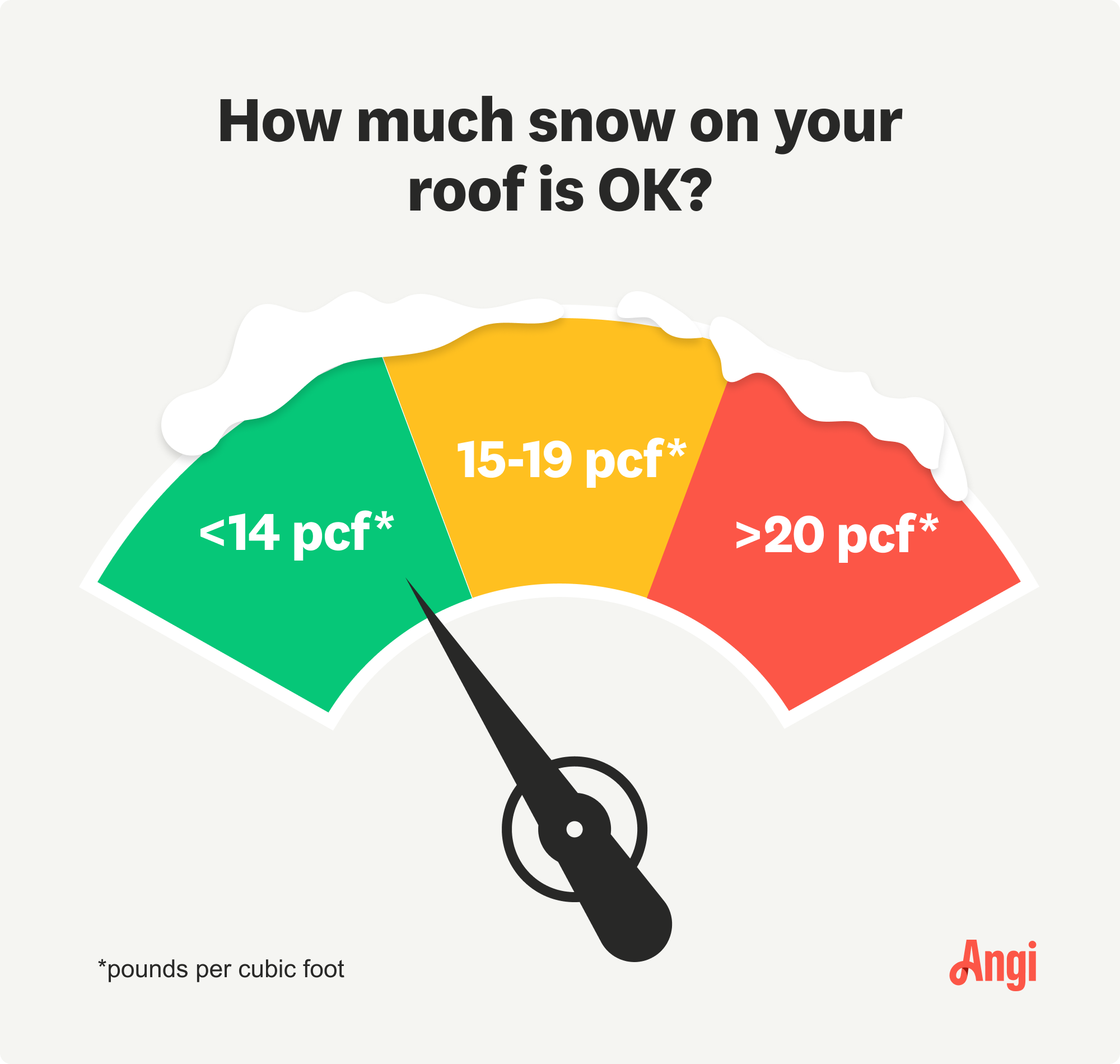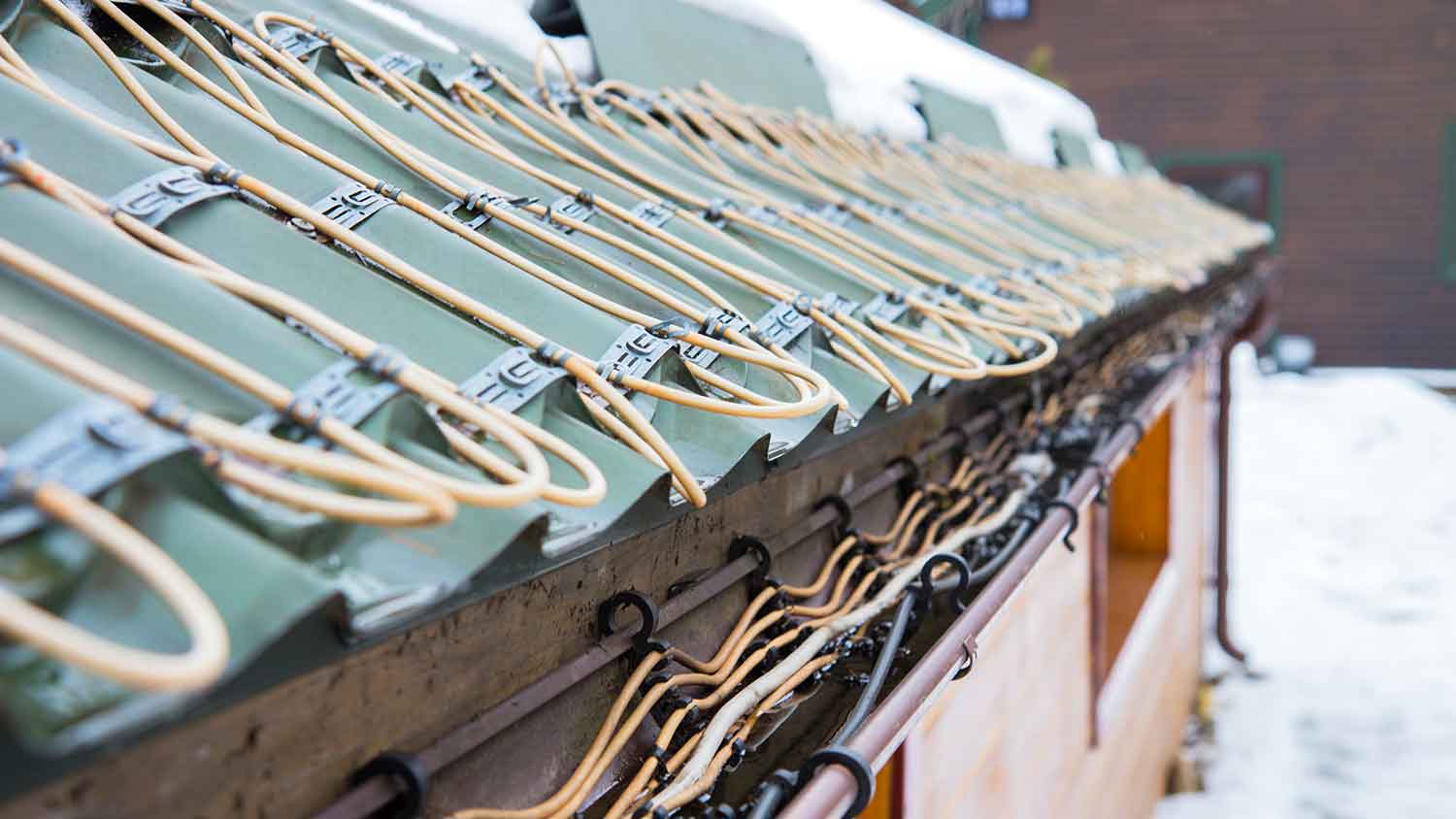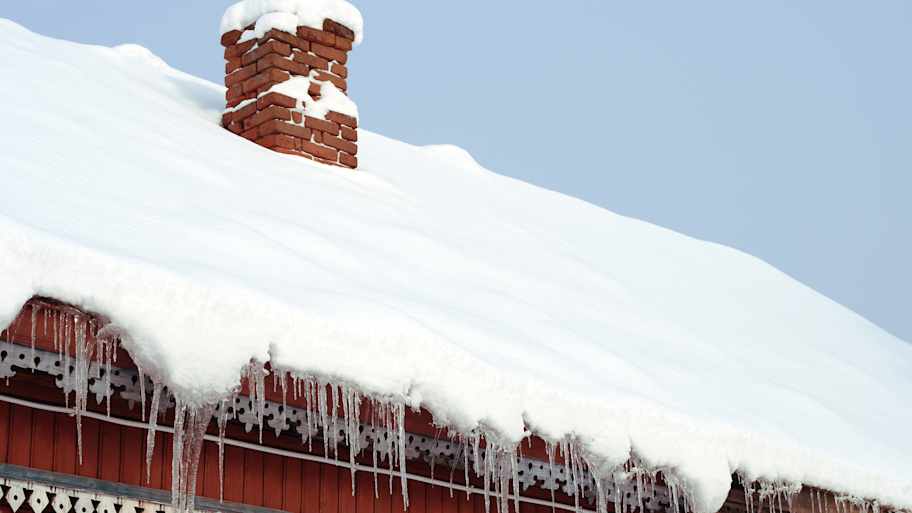
Discover the average cost of roof snow removal, key price factors, and ways to save. Get transparent estimates to protect your home this winter.
Whether you rake, de-ice, or lasso, roof snow removal protects your home


Nothing makes a neighborhood look more cozy and wintry than snow-capped roofs. But when that snow comes down too fast and heavy or accumulates over several storms, it can actually endanger your roof and your home. Follow the helpful tips below to remove snow from your roof and avoid collapse, ice dams, leaks, roofing damage, and dangerous falling piles of snow.
If you have a steeply sloped roof, you may never need to remove snow as it’s more likely to slide off before it accumulates in dangerous amounts.
Low-slope or flat roofs, however, are a different story. Without slope or pitch, snow can build up in deep drifts that compact and get heavier over time as it melts, refreezes, and forms ice dams. Flat roofing is usually not as structurally sturdy as sloped roofs, so it may not be able to hold as much weight.
It is best to remove roof snow before it exceeds 12 inches in depth. For low-slope and flat roofs, take a more conservative approach and remove snow long before it hits the one-foot mark.
Keep in mind that snow compacts, becoming heavier as it sits, even though it may look as though it is shrinking. Remember to clear gutters and downspouts when you remove snow so that any meltwater can easily flow off your roof and prevent formation of ice dams and icicles.
It is also important to factor in new snowfall, especially when it is forecast to be wet and heavy. If snow has already accumulated on your roof before an impending storm, take the safe route and remove existing snow to make room for new accumulation. That way, you will not find yourself raking snow off a roof during a blinding snowstorm.

Ideally, you should remove snow proactively before it gets to the point of being too heavy for your roof. Once you see signs that the weight is too much, your roof can already have irreversible damage. Still, it is good to know what to look for. Here are some common signs that it is past time for roof snow removal:
Creaking, groaning, or cracking noises from your roof joists or attic area
An actively sagging roof or ceiling
Ceiling boards, drywall, or other ceiling material shifting, cracking, or moving
Bowing or sagging roof decking, plywood, trusses, beams, or supports
Wall or masonry cracks
Water spots or roof leaks that appear suddenly or worsen quickly
Doors that suddenly take effort to close or will not open or close
If your home has an older roof, if you have had any problems with leaking or snow weight in the past, if a lot of heavy snow is in your forecast, or if you are concerned about your roof’s ability to handle snow load for any reason, call a professional roofing contractor near you to inspect your roofing and let you know whether it is safe or needs replacement or repair.
Any work on or around roofs can be dangerous, and that danger is amplified when dealing with heavy snow, icicles, or ice dams that can fall and cause injury. Caring for your roof is important, but make sure you are caring for yourself first and foremost with these tips:
Stay safely on the ground. Snow-covered roofs are a major fall hazard, and ladder rungs will become icy and slippery in snowy weather.
Always have someone with you to help if needed and watch out for potential problems or emergencies.
Watch out for falling snow at all times. A square foot of snow weighs 20 pounds or more, and even smaller piles can injure or even kill people and pets.
Keep pets and children inside or far away from the roofline while you are working.
Dress warmly and cover extremities to guard against frostbite and hypothermia; wear layers so you can remove just enough to regulate your temperature.
Take regular breaks to get warm and give your body a rest from strenuous work.
Never attempt snow removal if you have heart problems, are not healthy and fit, or are unable to move quickly to avoid falling snow.
Be cautious near power lines or electrical boxes.
If you are using metal tools, consider buying a nonmetal extension pole to protect you from accidental electrocution.
No matter the method you choose, the first step should be to ensure you take all safety precautions possible and have someone to help or observe in case you need help. Next, take the time to make a path around your home so that you can move more easily and safely while removing snow from your roof. Use a snowblower or shovel, or use snowshoes or heavy boots to tamp down a path. Then, decide the best method for how to get the snow off your roof, and have all of your tools and equipment ready and handy before you begin.
Roof rakes are a great option for most roofs. Long and light with grooves, prongs, or a rubber squeegee-like blade at the end to pull snow off a roof without requiring a ladder, roof rakes are a good tool for removing snow at the edge of a roofline. They help prevent heavy snow buildup, ice dams, icicles, and other dangerous winter roof conditions.
Assemble the roof rake according to manufacturer directions (if required).
Stand on the ground as far away as possible to stay clear of falling snow.
Lift the roof snow rake above your head using both hands and place the tines, prongs, or squeegee blade into the snow on your roof.
Pull it toward you, dragging the snow off the roof in sections. Working in smaller sections will make it easier to remove deep, heavy, or wet snow.
Do not scrape all the way down to your roof’s surface to avoid causing damage; aim to leave about an inch of snow in place.
Take several swipes of smaller amounts of snow to avoid overtaxing yourself.
Take breaks as needed as you work around the roof in sections.
Chemical de-icers have the potential to harm your roof and gutters permanently if you choose the wrong one or use it incorrectly. For this reason, always pick a roof-safe de-icer made of calcium chloride and labeled as compatible with your type of roofing. Then, use it exactly as the manufacturer intends, following all packaging instructions. You can proactively place de-icer on your roof before winter or ahead of forecasted storms, or you may place it after snow and ice have begun to build up.
Here is one way experts recommend using calcium chloride de-icers:
Fill a nylon stocking or tube sock with de-icer granules; tie off the open end.
Toss or place the stocking onto your roof, with the toe or tied-off end pointing down toward the ground (perpendicular to the gutters).
Place filled tubes every three to five feet, paying attention to areas where the roof drains or where you have had trouble with snow and ice buildup.
The de-icer will activate, slowly melting channels into the snow and ice, allowing the water to drain off the roof, and opening up the roofing to let the sun’s rays warm it and help melt off surrounding snow.
A simple length of rope can be a great tool to remove snow buildup from single-story roofs. For this method, you will ideally want to have two people; however, if snow removal is a one-person job in your household, you can tie a heavy object to one end of the rope to act as a counterweight to your pulling motions. Only attempt this method if you are sure of your ability to do it safely; otherwise, call a pro.
Choose a rope that is long enough to span the width of your roofing and give you enough slack to hold or secure both ends near ground level.
Holding one side of the rope firmly in your hands, toss the other end over to a second person on the opposite side. You may want to secure the rope to an object or knot the end several times to make it easier to toss.
With both people grasping tightly to their side of the rope, pull back and forth in a sawing motion, moving slowly toward the edge of the roof.
The motion of the rope should help dislodge snow and pull it down and off the roof.
Note: Use caution as you do this, maintaining a safe distance from the roof so that you do not get hit by heavy piles of falling snow.
There are many methods for getting snow off roofs, but you need to choose a safe one. Preventing roof damage is key when removing snow; after all, you are removing heavy snow and ice in order to protect your roof and its integrity. Using damaging tools to remove snow is counterintuitive, as they can leave your roof scratched or compromised.
Never use metal shovels, rakes, hoes, ice picks, or similar metal tools on your roofing. Metal tools can scratch, dent, and permanently damage roofing, leaving it vulnerable to water intrusion and leaks. Instead, choose a snow rake or similar tool that is made to remove snow from roofs safely and without causing damage.
It is tempting to throw a few handfuls of rock salt up onto your roof and let it melt the ice and snow away with no other efforts from you. After all, it melts ice and snow from your driveway; would it not be just as effective on your roof?
The answer is that, while it will melt snow and ice no matter where you put it, rock salt can severely damage your roof and gutter system, causing even bigger problems in the future. Salt is corrosive, so it will eat away at shingles and cause gutters and downspouts to rust and form holes. If you must use a de-icer, look for non-corrosive de-icing products made of calcium chloride, and use according to manufacturer instructions.
Electric heating tools such as hair dryers, heat guns, flame-making devices, and other hot tools can cause flooding and avalanche-like snow collapse and even melt roofing in some cases, which makes for dangerous situations and permanent damage. In some cases, homeowners have even set their homes on fire while attempting to melt snow with electric or open-flame devices. Never use these items on your roof—and seriously question any roof snow removal company that offers to use them for you.
By removing snow, you can help prevent ice dams, icicles, and roof damage. That is a lot of benefit for a moderate amount of work. Here, we cover the best ways to remove heavy roof snow and prevent ice dams from forming on your roof.
Remember, compacted snow can be very heavy, so removing it before it gets too deep and solid can save your back and your roof.
Do not scrape snow completely off your roof; aim to leave about an inch of snow covering the surface of your roof to prevent damage.
Plan ahead. It is smarter to remove snow more frequently or before storms hit, rather than trying to do it all at once, during a snowstorm, or after it has reached a dangerous point.
Removing snow from your roof might seem like an easy DIY task. After all, snow is light and fluffy, right? Not when it is piling up on your roof. As tempting as it is to save on snow removal costs by doing the job yourself, it can be a tricky business. Snow compacts quickly and can become icy, heavy, and dangerous even mere hours after a storm.
If you are in good shape, do not have a history of cardiac problems, and own the tools you need, you should be able to remove snow from a roof yourself. However, because roof work of any kind can be dangerous, there is nothing wrong with bringing in a pro to do the heavy lifting. In fact, roof snow removal is one of those home maintenance tasks that is often well worth the price of having someone else do it for you.
Good roofing contractors near you will have all of the licensing, insurance, tools, and expertise they need to do the job quickly, effectively, and safely. On average, professional snow removal services cost $300, but you can expect to pay as little as $200 or as much as $700 depending on your location, roof size, and the professional you choose to hire. It can also be helpful to hire an experienced roof cleaner near you from time to time to help maintain the integrity of your home’s roof.
From average costs to expert advice, get all the answers you need to get your job done.

Discover the average cost of roof snow removal, key price factors, and ways to save. Get transparent estimates to protect your home this winter.

Discover the average roof heating cable installation cost, key price factors, and how to budget for your project. Learn how to save and what to expect.

Winter’s icy chandeliers can pose more of a hazard than you might think. So should you knock down icicles or let them disappear with warmer weather? Find out here.

It’s snowing up a storm outside when you start to wonder: How much snow can my roof hold? Use our snow load calculator to determine your roof’s limits.

Ice dams can seriously damage your roof and home. Learn what causes them and how to prevent ice dams from forming this winter.

Say farewell to gutter-clogging ice that ruins roofs and puts a damper on enjoying the cold weather. Learn how to remove ice dams yourself in this guide.